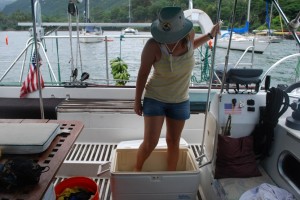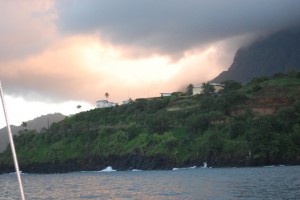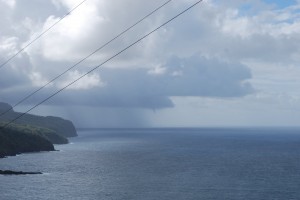Today’s news is pretty mundane compared to the last blog. It rained off and on until the early afternoon, but we still managed to get a few things done. The girls went to town in the morning to get some groceries, and I replaced a section of wire for the red port running/navigation light that had gotten too dim to see during our passage. The original wiring from 1989/1990 used non-tinned copper wire and some of the more exposed sections have had to be replaced. The individual copper strands in the wire become covered in black with what I’m assuming is galvanic corrosion. Many of the more exposed wires that are working fine need to be “shined” with sandpaper before the solder will stick to them. Wes was also able to get the water pump working properly today. For the last week or so, it hasn’t shut off on its own, so we’ve had to only turn it on when we need to use a faucet. The pump is responsible for pumping fresh water from our tanks and keeping the water pressure similar to a typical house in the US. When all the faucets are off, it should turn off within a minute or so, after increasing the pressure in the water lines to a preset amount. Unfortunately, it hasn’t been shutting off, and Wes had already tried replacing the pump with one of the used spares that was aboard the boat when we bought it. After a fair amount of work over the last couple days, he was able to isolate the problem to an intake hose and things are working fine now.
This afternoon Tiff & Wes made their first attempt at doing laundry ourselves sans washing machine or drier. The Swiss woman here in the anchorage told us her favorite method was to use her feet, standing in a cooler or bucket of clothes and water/detergent then stomping around a bit — like a washing machine she said, with the added bonus of very clean feet when you’re done. Tiff tried a similar method and in half an hour or so, she and Wes had their laundry hanging up on the lifelines around the boat. The sun and wind didn’t cooperate and dry them quickly, but they seemed to do pretty well for the first attempt. Lauren and I will be in for our first attempt sometime in the next few days.
Lauren and I had a shower tonight (still getting used to having an unlimited running water shower nearby), which is generally not an extremely noteworthy event, but if you remember the shower here, it’s just a concrete box in the shape of the number 9 with a clothes-washing shelf as part of the same structure. The French couple with the child that’s almost two came up and were washing some clothes while waiting for a shower. They’re really nice, speak a little bit of English, and just left from France last December. The funny part is that I’m having this conversation with them while Lauren is in the “shower”: about 2 feet away. Then it’s my turn for a shower, and I listen to and watch the nice conversation Lauren is having while I’m enjoying the cold water from the pipe in the dim glow from a parking lot lamp nearby. Just another one of those random things that would be so out of place in the states but is as normal as can be out here.
Because it’s fairly easy here, we’ve stocked up on water even though people are saying the quality isn’t very good. We’ve had no problems yet. Wes pours the water into the tanks through a sediment filter that traps any big stuff (you’d be surprised) and then treats the water with chlorine to kill the nasties. An in-line charcoal filter then does a pretty good job of taking out the rest of the junk and the chlorine taste. Such is life these days. I remember when all I had to do was put the glass under the faucet and turn the knob. Cruisers talk about some funny things, and water is actually one of the interesting ones here in the Marquesas. It’s plentiful because the high islands induce a lot of rainfall, and in some of the bays you can walk to waterfalls or pristine streams in now-uninhabited valleys that provide what we’ve heard is some of the best tasting water in the world. With such interesting and pure water sources available, people are always discussing whether to use the tap water here or there or to hold out until they’re in such and such bay and then lug their water jugs to the “good water”. Between here and the Galapagos, we’ve carried the 50-pound water jugs enough already to prefer the short walk with a dose of chlorine.
One of the things here that the cameras don’t seem to do a good job with is the clouds around the mountain peaks. It’s hard to describe, but almost mesmerizing to watch sometimes. My favorite is when the bottom of the clouds is near the top of the mountain and there a good wind blowing. The thin clouds sweep and churn around the jagged peaks like some sort of fluid dynamics experiment. Clouds usually look pretty boring, but when you see them interact with something as large a mountain top, they really become more dynamic and their varying character over the day become much more noticeable. The larger mountains are to the west of us and the last couple of nights at sunset, the clouds have dropped lower down the mountainsides and the sun turns them a dusky orange in places. It really looks like half the island is on fire The only similar thing I’ve seen is wildfires in California. On a final cloud note, on the drive to Taaoa yesterday, we saw the beginnings of a waterspout coming down from a thick heavy cloud that was hovering over the south coast of Hiva Oa. Waterspouts are the marine version of a tornado, but they’re not nearly as dangerous. They’re generally much weaker and short lived and often never touch down, but they are interesting to see.
Tomorrow we’re planning to leave Taahuku Bay and head for Tahuata, which is the island just south of Hiva Oa. We’ve heard about a clear bay that would be good for diving or snorkeling, there are artisans on the island who carve wood and bone that is usually sold in Tahiti, and there is a bay with an interesting history related to Captain Cook stopping there and the French choosing to declare possession of the Marquesas there as well. After that, we’re probably going to stop in one of the uninhabited bays on the north side of Hiva Oa before heading to the island of Ua Pou. I’m not sure what the internet situation is going to be like there, but it probably won’t be great, so we may be back to sat phone blogs and no pics for a while.




